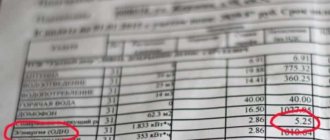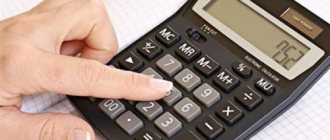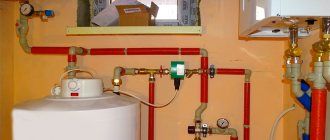The peculiarity of the calculation of such consumers is that, in addition to the consumption of their living space (room), they must pay for the consumption of the common areas of the communal apartment. Such places, for example, are the bathroom and kitchen. The consumption of these places should be distributed among all owners of rooms in a communal apartment. The calculation is made in one of the following ways: 1st method: If the communal apartment is equipped with a common (apartment) metering device and all rooms are equipped with room metering devices
.
2nd method: If the communal apartment is equipped with a common (apartment) metering device and not all rooms are equipped with room metering devices.
The calculation of the amount of payment for electricity provided to a consumer living in a room equipped with a room electricity meter is carried out based on the readings of the room meter and the agreement reached between all consumers in a communal apartment on the procedure for determining the volume (quantity) of electricity consumed in premises that are common property owners of rooms in a communal apartment (bathrooms, kitchens, etc.), and its distribution among all consumers of the communal apartment. The specified agreement must be drawn up in writing, signed by all consumers of the communal apartment or their authorized representatives and transferred to the guaranteeing supplier.
3rd method: If the communal apartment is equipped with a common (apartment) metering device and not all rooms are equipped with room metering devices. (there is no written agreement reached between all consumers of the communal apartment)
In this case, readings from room meters are not taken into account when calculating the amount of payment for consumed electricity. The calculation is made as follows:
4th method: If the communal apartment is not equipped with a common (apartment) metering device
The calculation of the amount of payment for utility services provided to consumers in residential premises in corridor, hotel and sectional type dormitories (with the presence of common kitchens, toilets or shower blocks on the floors) is carried out in the manner established for calculating the amount of payment for utility services for consumers living in a communal apartment.
Regulatory framework: - clauses 50 and 51 of the Rules for the provision of utility services to owners and users of premises in apartment buildings and residential buildings, approved by Decree of the Government of the Russian Federation of May 6, 2011 No. 354 “On the provision of utility services to owners and users of premises in apartment buildings houses and residential buildings."
Accrual procedure
The procedure for charging for electricity in the premises of an apartment building and residential building
(in accordance with the Rules for the provision of public services, approved by Government Decree dated 05/06/2011 No. 354)
1. The amount of payment in a room equipped with an individual or shared (apartment) metering device is determined based on the readings of the metering device.
2. The amount of payment in a residential premises in the absence of an individual or common (apartment) electricity meter is determined based on the utility service consumption standards.
3. In relation to a utility service for electricity supply, when the responsibility for installing individual, common (apartment), room metering devices is assigned to the guaranteeing supplier (grid organization - in relation to a residential building (household), payment for electricity provided to the consumer in a residential or non-residential premises for the billing period, is determined based on the calculated average monthly consumption of a utility resource by the consumer, determined according to the readings of an individual or general (apartment) meter for a period of at least 6 months, and if the period of operation of the meter was less than 6 months, then for the actual period of operation metering device, but not less than 3 months, in the following cases and for the specified billing periods:
a) in case of failure or loss of an individual, general (apartment), room metering device previously put into operation or the expiration of its service life, determined by the period of time before the next verification - starting from the date when the specified events occurred, and if the date is set is impossible - then starting from the billing period in which the specified events occurred until the date when electricity metering was resumed by putting into operation an individual, general (apartment), room metering device that meets the established requirements;
b) in case of failure by the consumer to provide readings of an individual, general (apartment), room meter for the billing period within the time limits established by these Rules, or an agreement containing provisions on the provision of utility services, or a decision of the general meeting of owners of premises in an apartment building - starting from the billing period for which the consumer did not provide meter readings before the billing period (inclusive) for which the consumer provided the meter readings to the contractor;
c) if the consumer did not provide access to the representatives of the contractor and (or) the guaranteeing supplier to the residential premises occupied by the consumer on the date and time specified in the notice of inspection or in the consumer’s message, and at the same time in relation to the consumer living in the residential premises, these persons do not have information about his temporary absence from the occupied residential premises, such persons draw up an act of refusal of access to the electrical energy metering device - then from the date when the executor drew up an act of refusal of access to the metering device, distributors, until the date of the inspection, or until the 2nd act of non-admission is drawn up, but no more than 3 billing periods in a row, then the calculation of utility bills is based on the standard for electricity consumption, taking into account the number of permanent and temporary residents in the residential premises, including the specified in the act, taking into account the increasing coefficient. The value of the increasing coefficient is assumed to be 1.5.
In the absence of information about citizens permanently and temporarily residing in residential premises, the volume of utilities in these cases is calculated taking into account the number of owners of such premises.
The procedure for charging for electricity for common household needs (GDN)
(in accordance with the Rules for the provision of public services, approved by Government Decree dated 05/06/2011 No. 354)
1. The volume of “e/energy ODN” in an apartment building equipped with a collective (general building) metering device (ODPU) is determined as the difference between the general building consumption according to the UDPU and consumption in residential and non-residential premises and is distributed in proportion to the size of the area of residential and non-residential premises.
2. Payment for the utility service - electricity provided for common house needs for the billing period is determined based on the calculated average monthly volume of consumption of the utility resource, determined according to the readings of the collective (common house) metering device for a period of at least 6 months, and if the period of operation of the metering device was less than 6 months - then for the actual period of operation of the metering device, but not less than 3 months - starting from the date when the collective (common house) metering device previously put into operation failed or was lost or its service life expired, and if the date cannot be determined, - then starting from the billing period in which the specified events occurred until the date when the accounting of the utility resource was resumed by putting into operation a collective (common house) metering device that meets the established requirements, but no more than 3 billing periods in a row, then based on utility consumption standards services.
How to calculate the payment for electrical energy for your apartment?
Comments
Electricity supply is a public service, and in accordance with the Housing Code of the Russian Federation, it is a mandatory payment for which payment must be made.
Calculation of electricity charges
The rules for calculating the amount of payment for electricity supply are determined by Government Decree No. 354 of 05/06/2011 (hereinafter referred to as the Rules), as well as Government Decree No. 491 of 08/13/2006.
In accordance with paragraph 40 of the Rules, consumers in an apartment building pay a fee for electricity provided in residential or non-residential premises , as well as a fee for electricity consumed during the maintenance of common property in an apartment building - electricity provided for general house needs.
From 01/01/2017, the payment for electricity provided for general building needs, as a utility service according to the Rules, is calculated for consumers if, in an apartment building, the owners of the premises have chosen the direct control method, or the control method has not been chosen or not implemented.
If the owners of an apartment building have chosen the management method of a management organization, homeowners association, housing cooperative or other specialized cooperative, the electricity supply consumed during the maintenance of common property is included in the payment for the maintenance of residential premises and is calculated based on consumption standards established by local governments, or according to the readings of a common house appliance accounting, if such a decision was made at a general meeting of owners of the premises of such a house.
According to the current legislation, the calculation of the amount of payment for electricity provided in a residential premises (apartment) is determined based on the readings of an individual or general (apartment) meter, if the apartment is equipped with such a meter, or based on the consumption standard established for electricity supply, using a multiplying factor in the amount of 1.5, if the apartment has the technical possibility of installing an individual or common (apartment) metering device, but such a metering device is not installed, and the electricity tariff established in your region.
Payment for electricity consumed during the maintenance of common property is calculated based on the volume of consumption determined in accordance with the established standard, or the readings of a common house meter (depending on the chosen method of managing an apartment building), the total area of the premises occupied by the consumer and the tariff for electricity supply established in your region.
In this article, we will look at the procedure and examples of calculating the amount of payment for electricity provided in residential premises, and for electricity provided for general household needs, in accordance with the provisions of the Rules.
Calculation No. 1 - calculation of charges for electricity supply in an apartment if there is an individual meter
Calculation No. 2 - calculation of payment for electricity supply in an apartment in the absence of an individual metering device; there is no technical possibility of installing such a device
Calculation No. 3 - calculation of charges for electricity supply in an apartment in the absence of an individual metering device, but it is technically possible to install such a device
Calculation No. 4 - calculation of payment for electricity provided for common building needs, in the absence of a common building meter in an apartment building
Calculation No. 5 - calculation of payment for electricity provided for common house needs, a common house meter is installed in an apartment building
First, let's calculate the amount of payment for electricity provided in a residential premises (apartment).
Calculation No. 1 - an individual metering device for electricity supply is installed in your apartment.
If an individual meter for electricity supply is installed in your apartment, the calculation of the fee will be made according to formula No. 1 , as the product of the amount of electricity consumed in your apartment according to the readings of your individual meter and the electricity tariff established for your region and service provider:
Formula No. 1
Pi = ViP x Tcr
ViП - volume (quantity) of electricity consumed during the billing period in a residential or non-residential premises, determined according to the readings of an individual or general (apartment) meter.
Tkr is the tariff (price) for electricity supply, established in accordance with the legislation of the Russian Federation.
EXAMPLE OF CALCULATING THE AMOUNT OF PAYMENT FOR ELECTRIC SUPPLY USING FORMULA No. 1
First of all, we determine that this calculation is performed:
» for an apartment located in an apartment building; » the apartment has an individual meter for electrical energy;
INITIAL DATA FOR CALCULATION:
The volume of electrical energy consumed according to the readings of your individual meter for January 2019 amounted to 350 kilowatts (ViP - in the formula).
The electricity tariff established for your region and service provider is 3.20 rubles. for 1 kilowatt (Tcr - in the formula).
The amount of payment for electricity supply for your apartment will be calculated as follows:
350 kW x 3.20 rub. = 1120.00 rubles
The total payment for electrical energy in your apartment will be RUB 1,120.00.
Calculation No. 2 - your apartment does not have an individual meter for electricity supply, there is no technical possibility of installing such a device.
If your apartment does not have an individual meter for electricity supply, and there is no technical possibility of installing it, which is confirmed by the relevant act, the payment amount will be calculated according to formula No. 4 , as the product of the consumption standard established for your region, the number of citizens living in the apartment and the tariff . installed on the electricity supply for your region and service provider.
Formula No. 4
Pi = nj x Nj x Tcr
nj is the number permanently and temporarily residing in the apartment.
Nj is the standard established for electrical energy for your region.
Tkr is the tariff set for electrical energy for your region and service provider.
EXAMPLE OF CALCULATING THE AMOUNT OF PAYMENT FOR ELECTRIC SUPPLY USING FORMULA No. 4
First of all, we determine that this calculation is performed:
» for an apartment located in an apartment building; » there is no individual metering device installed for electrical energy; there is no technical ability to install an individual metering device;
INITIAL DATA FOR CALCULATION:
4 people living in your apartment (nj - in the formula).
The standard for electricity supply established for your region is 80 kilowatts per person (Nj - in the formula).
The electricity supply tariff established for your region and service provider is 3.20 rubles per 1 kilowatt (Tcr - in the formula).
The amount of payment for electricity supply for your apartment will be calculated as follows:
4 people x 80 kW x 3.20 rub. = 1024.00 rubles
The total payment for electrical energy in your apartment will be RUB 1,024.00.
Calculation No. 3 - your apartment does not have an individual meter for electricity supply, but it is technically possible to install such a device.
If your apartment does not have an individual meter for electricity supply, but it is technically possible to install it, the payment amount will be calculated using formula No. 4(1) , as the product of the consumption standard established for your region, the number of citizens living in the apartment and the tariff established for electricity supply for your region and service provider, as well as a multiplying factor of 1.5.
Formula No. 4(1)
Pi = nj x Nj x Kpov x Tcr
nj is the number permanently and temporarily residing in the apartment.
Nj is the standard established for electrical energy for your region.
Kpov - increasing coefficient equal to 1.5 from January 1, 2021.
Tkr is the tariff set for electrical energy for your region and service provider.
EXAMPLE OF CALCULATING THE AMOUNT OF PAYMENT FOR ELECTRICITY SUPPLY USING FORMULA No. 4(1)
First of all, we determine that this calculation is performed:
» for an apartment located in an apartment building; » the apartment does not have an individual meter for electrical energy, but it is technically possible to install such a meter .
INITIAL DATA FOR CALCULATION:
4 people living in your apartment (nj - in the formula).
The standard for electricity supply established for your region is 80 kilowatts per person (Nj - in the formula).
The increasing coefficient is 1.5 (Kpov - in the formula).
The electricity tariff established for your region and service provider is 3.20 rubles. for 1 kilowatt (Tcr - in the formula).
The amount of payment for electricity supply for your apartment will be calculated as follows:
4 people x 80 kW x 1.5 x 3.20 rub. = 1536.00 rubles
The total payment for electrical energy in your apartment will be RUB 1,536.00.
Now let’s calculate the amount of payment for electricity provided for general house needs.
Calculation No. 4 - the apartment building does not have a common building meter for electrical energy.
The calculation of the amount of payment for electricity provided for general house needs will be made according to formulas No. 10 and No. 15 . Formula No. 15 calculates the volume of electricity supply, and formula No. 10 calculates the amount to be paid.
Formula No. 10
Piodn = Viodn x Тcr
Viodn - volume (quantity) of electricity provided during the billing period for general building needs in an apartment building and per residential premises (apartment) or non-residential premises.
Tkr is the tariff for the corresponding utility resource (electricity), established in accordance with the legislation of the Russian Federation.
Formula No. 15
Nodn - the consumption standard for electricity provided for the billing period for general house needs in an apartment building, established in accordance with the Rules for establishing and determining standards for the consumption of utility services, approved by Decree of the Government of the Russian Federation of May 23, 2006 No. 306
Si - total area of residential premises (apartment) or non-residential premises in an apartment building
Sob - the total area of all residential premises (apartments) and non-residential premises in an apartment building
Soi - the total area of premises that are part of the common property in an apartment building
EXAMPLE OF CALCULATION OF THE AMOUNT OF PAYMENT FOR ELECTRICITY SUPPLY PROVIDED FOR GENERAL HOUSEHOLD NEEDS, ACCORDING TO FORMULA No. 15
First of all, we determine that this calculation is performed:
» payment for electricity provided for general building needs for an apartment located in an apartment building; » a common house meter for electricity supply is not installed in the apartment building ;
INITIAL DATA FOR CALCULATION:
The standard for electricity supply provided for general household needs , established for your region, is 1.5 kilowatts per 1 m2 (Nodn - in the formula).
The total area of the premises that are part of the common property of the owners of the premises of an apartment building is 400 m2 (Soi - in the formula).
The area of residential premises (apartments) of an apartment building is 6000 m2 (Sob - in the formula).
The total area of your apartment is 45 m2 (Si is in the formula).
The electricity tariff established for your region and service provider is 3.20 rubles. for 1 kilowatt (Tcr - in the formula).
The amount of payment for electricity provided for general house needs will be calculated as follows:
1. First of all, it is necessary to determine the volume of electricity provided for general house needs using formula No. 15 :
The total volume of electricity provided for general house needs will be 4.5 kW.
2. Then, we calculate the size of the fee using formula No. 10 :
4.5 kW x 3.20 rub. = 14.40 rubles
The total payment for electricity provided for general house needs will be 14.40 rubles.
Calculation No. 5 - a communal metering device is installed in an apartment building
The calculation of the amount of payment for electricity provided for general house needs , in this case, will be made according to formulas No. 10 and No. 12 . Formula No. 12 calculates the volume of electricity supply, and formula No. 10 calculates the amount to be paid.
Formula No. 10
Piodn = Viodn x Тcr
Viodn - volume (quantity) of electricity provided during the billing period for general building needs in an apartment building and per residential premises (apartment) or non-residential premises.
Tkr is the tariff for the corresponding utility resource (electricity), established in accordance with the legislation of the Russian Federation.
Formula No. 12
VD is the volume (quantity) of electricity consumed during the billing period in an apartment building, determined according to the readings of the collective (common house) utility meter.
∑uVutender. - volume (quantity) of electricity consumed during the billing period in non-residential premises, determined in accordance with paragraph 43 of the Rules.
∑vVvresidential — volume (quantity) of electricity consumed during the billing period in residential premises (apartment) not equipped with individual or common (apartment) metering devices.
∑wVwresidential - volume (quantity) of electricity consumed during the billing period in residential premises (apartment) equipped with individual or general (apartment) electricity metering devices, determined according to the readings of such a metering device.
Vcr - the volume of electrical energy used during the billing period by the contractor in the production of utility services for heating and (or) hot water supply (in the absence of centralized heating and (or) hot water supply), which in addition was also used by the contractor in order to provide consumers with utility services for electricity and (or) gas supply.
Si is the total area of residential premises (apartment) or non-residential premises in an apartment building.
Sob - the total area of all residential premises (apartments) and non-residential premises in an apartment building.
EXAMPLE OF CALCULATING THE AMOUNT OF PAYMENT FOR ELECTRICITY SUPPLY PROVIDED FOR GENERAL HOUSEHOLD NEEDS, ACCORDING TO FORMULA No. 12
First of all, we determine that this calculation is performed:
» payment for electricity provided for general building needs for an apartment located in an apartment building; a communal metering device for electricity supply was installed in the apartment building ; » there are no non-residential premises in the apartment building.
INITIAL DATA FOR CALCULATION:
The volume of electrical energy consumed according to the readings of the general house meter was 18,000 kilowatts (VD - in the formula).
The volume of electrical energy consumed in all residential premises according to the readings of individual metering devices amounted to 11,000 kilowatts (Vwresidential - in the formula).
The volume of electrical energy consumed in residential premises not equipped with individual metering devices amounted to 6,000 kilowatts (Vvzh.n. - in the formula), the calculation of the volume of electricity provided in premises not equipped with an electric energy monitoring device is based on the number of residents in these premises and the established consumption standards.
The area of residential premises (apartments) of an apartment building is 6,000 m2 (Sob - in the formula).
The total area of your apartment is 45 m2 (Si is in the formula).
The electricity tariff established for your region and service provider is 3.20 rubles. for 1 kilowatt (Tcr - in the formula).
The amount of payment for electricity provided for general house needs will be calculated as follows:
1. First of all, it is necessary to determine the volume of electricity provided for general house needs using formula No. 12 :
The total volume of electricity provided for general house needs will be 7.5 kW.
2. Then, we calculate the size of the fee using formula No. 10 :
7.5 kW x 3.20 rubles = 24.00 rubles.
The total fee for electricity provided for general house needs will be 24.00 rubles.
If you have questions about calculating the amount of electricity charges, you can ask them in the comments to this article or post them on our forum.
Legality of charging fees for ODN (KR SOI) above the standard
Question: We have a common electricity meter installed in our apartment building, which automatically transmits readings. The management company issues invoices according to ODN (KR SOI), which are calculated according to the standard. How to force the management company to pay for one-time tax according to the meters, and not according to the standard?
Answer from KS Citadel experts
First of all, it should be noted that from January 1, 2021, the payment for common house needs “migrated” from utilities to the payment for services for the maintenance and repair of the common property of an apartment building in the form of payment for utilities (resources) consumed in the maintenance of the common property in an apartment building (KR SOI).
It is impossible to answer the question categorically, since it is not clear from the question whether the fee for CD SOI is charged in excess of the standard or not.
To verify the correctness of the calculation of the fee for the CD SOI, it is necessary to file a claim with the management organization and/or the state housing supervision authority with a corresponding statement. If a violation of consumer rights is established, the state housing supervision authority will issue a mandatory order to the responsible person. The application can be downloaded HERE.
Let’s look at the question “on the fingers”. The apartment building is equipped with a collective (shared) electricity meter. In general, the MKD consumed 10,000 kW per month. Individual consumption (apartment-by-apartment) accounted for 7000 kW. 3000 kW remains in the air. It is these 3000 kW that the management/resource supply organization distributes to all residential/non-residential premises in the apartment building belonging to the owners. And in this case, it is necessary to figure out whether there is a supernominative accrual of the SOI CD or not.
Another situation is possible when consumption at the Kyrgyz Republic SOI is below the standard volume, but the utility provider continues to charge the standard volume at the permissible maximum, unreasonably increasing its profits.
It is possible to figure out whether the utility service provider is correctly accruing the KR SOI or not, either by requesting the necessary information from the provider and making a calculation, or by contacting the state housing supervision authority with an application. A sample is shown above.
It is impossible to force the contractor to charge ODN according to the ADP, because, firstly, there is no ODN meter (KR SOI), and secondly, the contractor already charges for electricity according to the readings of the common building meter based on the actual electricity consumption of the entire apartment building.
If we nevertheless assume that the fee is charged in excess of the consumption volume, then in this case, in the absence of a decision of the general meeting of owners, the fee is charged unlawfully.
Legal basis
In accordance with paragraph. 2 clause 44 of the Rules for the provision of utility services, approved by Decree of the Government of the Russian Federation of May 6, 2011 No. 354, distributed in accordance with formulas 11 - Appendix No. 2 to these Rules between consumers, the volume of utility services provided for general house needs for the billing period cannot exceed volume of utility services, calculated on the basis of consumption standards of the corresponding utility resource for the purpose of maintaining common property in an apartment building, except for cases where the general meeting of owners of premises in an apartment building, held in the prescribed manner, decided to distribute the volume of utility services in the amount of excess volume communal services provided for general house needs, determined based on the readings of a collective (common building) metering device, over the volume calculated on the basis of standards for the consumption of communal resources for the purpose of maintaining common property in an apartment building, between all residential and non-residential premises in proportion to the size of the total area of each residential and non-residential premises
Those. if the amount of payment for ODN according to the ODPU (formula 12) exceeds the standard amount without ODPU (formula 15), then the fee for ODN for electricity is charged no more than the normative amount.
By virtue of para. 4 of paragraph 29 of the Rules for the maintenance of common property of apartment buildings, approved by Decree of the Government of the Russian Federation of August 13, 2006 No. 491, with subsequent inclusions, the amount of the specified costs for paying for utility resources consumed in the maintenance of common property in an apartment building is determined based on the consumption standards of the relevant types of utilities resources for the purpose of maintaining common property in an apartment building, approved by state authorities of the constituent entities of the Russian Federation in the manner established by the Government of the Russian Federation, at tariffs established by state authorities of the constituent entities of the Russian Federation in the manner established by federal law. If the list of works for the maintenance of common property exceeds the minimum list, the general meeting of owners of premises in an apartment building has the right to decide to include in the payment for the maintenance of residential premises the costs of purchasing the amount of utility resources consumed in maintaining the common property in an apartment building, taking into account the excess standards for the consumption of relevant types of communal resources for the purpose of maintaining common property in an apartment building.
In the absence of an appropriate decision of the general meeting of owners, the demand for payment for utilities consumed for the maintenance of common property in an apartment building in an amount exceeding the standard for the consumption of utilities is unlawful.





